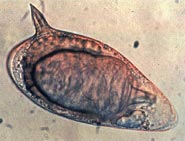Schistosomatidae
| Schistosomatidae | |
|---|---|
 |
|
| Egg of Schistosoma mansoni | |
| Scientific classification | |
| Kingdom: | Animalia |
| Phylum: | Platyhelminthes |
| Class: | Trematoda |
| Order: | Strigeidida |
| Superfamily: | Schistosomatoidea |
| Family: |
Schistosomatidae Poche, 1907 |
Schistosomatidae is a family of digenetic trematodes with complex parasitic life cycles. Immature developmental stages of schistosomes are found in molluscs and adults occur in vertebrates. The best studied group, the blood flukes of the genus Schistosoma, infect and cause disease in humans. Other genera which are infective to non-human vertebrates can cause mild rashes in humans.
Schistosomatids are dioecious (individuals are of separate sexes) which is exceptional with regards to their phylum, Platyhelminthes, in which most species are hermaphrodidic (individuals possess both male and female reproductive systems).
The eggs of these parasites were first seen by Theodor Bilharz, a German pathologist working in Egypt in 1851 who found the eggs during the course of a post mortem. He wrote two letters to his former teacher von Siebold in May and August 1851 describing his findings. von Siebold wrote a paper (published in 1852) summarizing Bilharz's findings. Bilhart's wrote a paper in 1856 describing the worms more fully and he named them Distoma haematobium. Their unusual morphology meant that they could not be comfortably included in Distoma so in 1856 Meckel von Helmsback created the genus Bilharzia for them. In 1858 Weinland proposed the name Schistosoma (Greek: 'split body') after the male worms' morphology. Despite Bilharzia having precedence the genus name Schistosoma was officially adopted by the International Commission on Zoological Nomenclature.
In 1898 all the then known species were placed in a subfamily by Stiles and Hassel. This was then elevated to family status by Looss in 1899. Poche in 1907 corrected a grammatical error in the family name. The life cycle was determined by da Silva in 1908.
There are a number of different families of blood fluke including the Schistosomatidae. The others include the spirorchiids (turtle parasites) and the sanguinicolids (fish parasites).
...
Wikipedia
